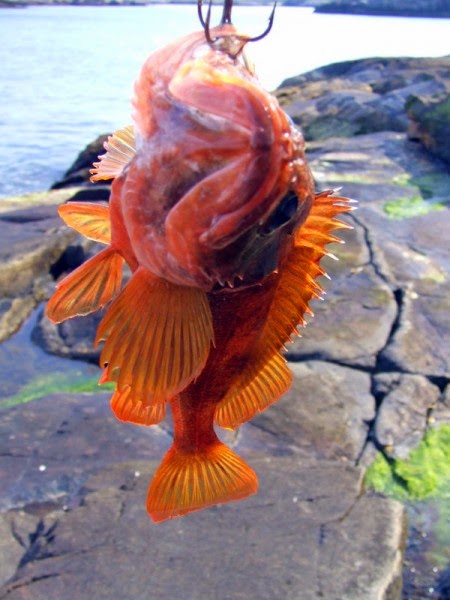Golden sea perch

The golden perch fish, Latin name Sebastes marinus (L.), is one of the sea perch that fishermen enjoy catching.
Content
- What kind of fish is golden sea perch?
- What does golden sea perch look like?
- Where are golden sea perch found?
- What does golden sea perch eat?
- How do golden sea perch spawn?
- Golden sea perch lifestyle
- Recreational fishing for golden sea perch
What kind of fish is golden sea perch?
Golden sea perch is a bottom-dwelling, deep-sea fish. It gathers in schools and usually lives on rocky ground, covered with silt and shells, at a depth of 200–300 m. The highest concentrations of sea perch are observed at water temperatures of at least 2–3° C.
What does golden sea perch look like?
The perch is bright red in color, its belly is pinkish or yellowish-white, and all its fins are orange-red. Sea perch has a length of up to 122 cm (in the Barents Sea - up to 89 cm, weight up to 9 kg).
Where are golden sea perch found?
Golden sea perch are distributed from the Kattegat to the northern North Sea, off the coast of Scotland and Ireland north to the west coast
Spitsbergen; in the southern part of the Barents Sea, golden sea perch to the southwestern slope of the Gusinaya Bank and the eastern part of the Murmansk shallow waters. Single individuals reach Matochkina Shar and Kaninsky district. Golden sea perch is also found off the coast of Iceland, Greenland and Labrador. Sometimes golden sea perch is found in the White Sea.
What does golden sea perch eat?
Golden sea perch feeds mainly on planktonic crustaceans and shrimp, occasionally feeding on juvenile capelin, cod and some other fish.
Adult perches with a body length of more than 34 cm feed on crustaceans (gammarids and shrimp) and some species of fish (capelin, luminous anchovies, juvenile cod, blue whiting).
How do golden sea perch spawn?
Golden sea perch is a viviparous fish. Insemination occurs in February. After insemination, females are grouped in places where larvae are deposited, located in the zone of action of branches of the North Atlantic Current. The hatching of larvae is one-time, occurring at a temperature of 5–7° C above great depths in March–June (the height is in April–May).
Golden sea perch lifestyle
Fry 32-57 mm long are found near the shores to a depth of 174 m. Adult golden sea perch are caught at depths of 20-730 m, preferring depths of 120-400 m in all areas of their habitat.
In the fall, golden sea perch tend to reach the shallowest depths, and in late winter and early spring they descend to the deepest.
Golden sea perch are much less confined to the bottom than small sea perch.
Recreational fishing for golden sea perch
In recreational fishing, golden sea perch is rarely found as bycatch; the weight of caught sea perch rarely exceeds 300 grams. As bait for catching sea perch, they use mussels, liver and other similar bait.